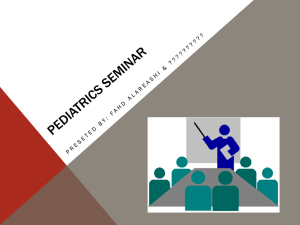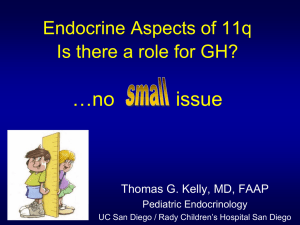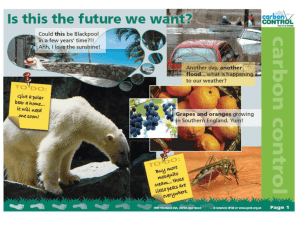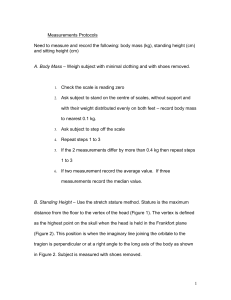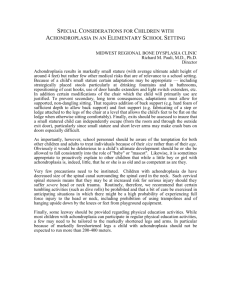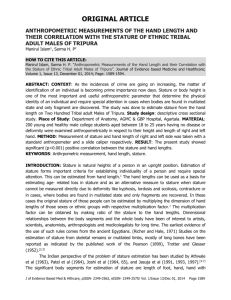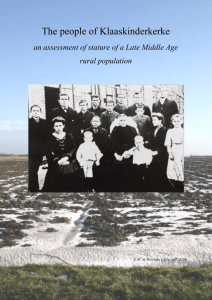Information S1.
advertisement
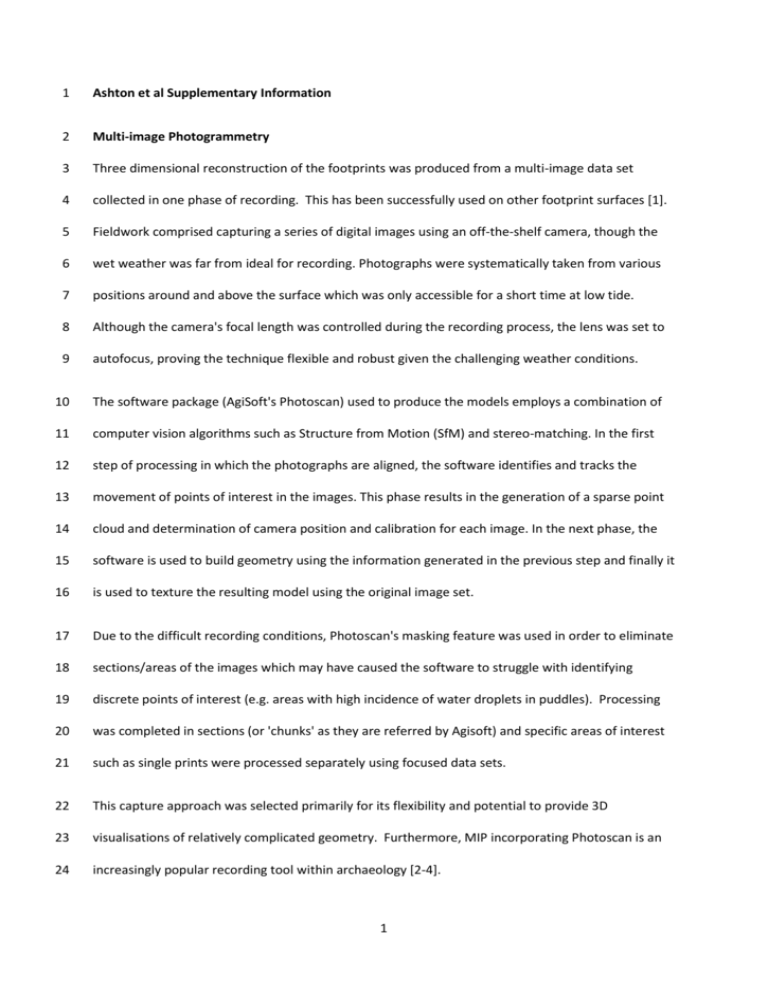
1 Ashton et al Supplementary Information 2 Multi-image Photogrammetry 3 Three dimensional reconstruction of the footprints was produced from a multi-image data set 4 collected in one phase of recording. This has been successfully used on other footprint surfaces [1]. 5 Fieldwork comprised capturing a series of digital images using an off-the-shelf camera, though the 6 wet weather was far from ideal for recording. Photographs were systematically taken from various 7 positions around and above the surface which was only accessible for a short time at low tide. 8 Although the camera's focal length was controlled during the recording process, the lens was set to 9 autofocus, proving the technique flexible and robust given the challenging weather conditions. 10 The software package (AgiSoft's Photoscan) used to produce the models employs a combination of 11 computer vision algorithms such as Structure from Motion (SfM) and stereo-matching. In the first 12 step of processing in which the photographs are aligned, the software identifies and tracks the 13 movement of points of interest in the images. This phase results in the generation of a sparse point 14 cloud and determination of camera position and calibration for each image. In the next phase, the 15 software is used to build geometry using the information generated in the previous step and finally it 16 is used to texture the resulting model using the original image set. 17 Due to the difficult recording conditions, Photoscan's masking feature was used in order to eliminate 18 sections/areas of the images which may have caused the software to struggle with identifying 19 discrete points of interest (e.g. areas with high incidence of water droplets in puddles). Processing 20 was completed in sections (or 'chunks' as they are referred by Agisoft) and specific areas of interest 21 such as single prints were processed separately using focused data sets. 22 This capture approach was selected primarily for its flexibility and potential to provide 3D 23 visualisations of relatively complicated geometry. Furthermore, MIP incorporating Photoscan is an 24 increasingly popular recording tool within archaeology [2-4]. 1 25 26 Footprint measurements 27 In situ measurement of the footprints was not possible, so the analysis was based on the MIP 28 vertical images. Initially 35 complete footprints were measured, but after re-measuring only those 29 that gave consistent readings (within 10% of the first reading), 12 prints were finally measured and 30 included in the metric analysis. 31 32 The possible number of individuals was determined by comparison of footprint length. Experimental 33 footprints have shown mean errors of between 1.7% and 14.5% to foot length [5] therefore 34 footprints falling within ±10% of each other were considered to have been made by the same or a 35 similar-sized individual. This resulted in five possible clusters, perhaps representing five individuals. 36 Footprints 5, 20 and 43 are more difficult to distinguish from footprints 3 and 45, and could be 37 interpreted in several ways. 38 39 Stature was calculated from footprint length as an approximation of foot length [4]. A global ratio of 40 foot length:stature was reported as 0.15 [6] and studies on various modern populations support this. 41 Davenport reported foot length:stature ratios ranging from 0.137 in Galibi Indians to 0.16 in 42 Bavarians [7]; the unshod Daasenach have ratios between 0.138 and 0.162 (mean = 0.15) [5]; eleven 43 Native American populations had mean ratios of 0.149 [8]; and the cold-adapted Akiak Eskimo 44 yielded mean male and female ratios of 0.146 and 0.145 respectively [9]. Therefore for this paper 45 the global ratio of 0.15 has been used, although with caution given the potential errors of estimating 46 height from footprints. 47 48 Stature comparisons with Early and Middle Pleistocene hominins are based on skeletal evidence 49 from Homo antecessor, H. heidelbergensis and H. neanderthalensis using regressions calculated from 50 stature: long bone length. Although this varies among different populations [10-12], it has been 2 51 suggested that Middle Pleistocene humans from Europe had similar body proportions to modern 52 temperate European populations [13]. Some researchers have also proposed that a global ratio 53 provides the most accurate predictor of stature when racial affinity is unknown [14-16]. Using 54 Euroamerican stature regressions from foot bones it has been estimated that Homo antecessor had 55 male and female statures of 1.73 ± 0.07 m and 1.68 ± 0.05 m respectively, which are taller than 56 male/female stature estimates for Neanderthals of 1.67 ± 0.06 m and 1.54 ± 0.05 m and for those 57 from Sima de los Huesos of 1.69 ± 0.04 m and 1.58 ± 0.02 m [17-19]. The stature estimates based on 58 the footprints at Happisburgh are consistent with those of H. antecessor. 59 60 Although body mass has been suggested to be higher relative to stature in populations from 61 northern latitudes [20], recent work by Stock et al. (personal communication) suggests that this 62 adaptation to cold is not seen in most European skeletal fossil assemblages. Because of this, the cool 63 temperate climate and the lack of comparative footprint regressions, body mass estimates are 64 calculated from footprint area using the ‘walk only’ regressions based on the Daasenach [5]. Given 65 these uncertainties, the body mass estimates for Happisburgh should be treated with caution. 66 67 Pollen Analysis 68 The sediment sample used for the pollen analysis was from the same set of sediments and within 15 69 m of the footprint surface. The sample was prepared by standard chemical procedures, then lightly 70 stained with safranin, dehydrated in tertiary butyl-alcohol, and the residues mounted in 2000 cs 71 silicone oil. Slides were examined at a magnification of 400x (1000x for critical examination) by 72 equally-spaced traverses across slides to reduce the possible effects of differential dispersal on the 73 slides. A count of 531 land pollen and spores was made. Pollen identification, where necessary, was 74 aided using the key of Moore et al. and a modern pollen reference collection [21]. 75 3 76 The pollen assemblage is dominated by coniferous pollen: pine (Pinus; 48%) accounts for about half 77 the total land pollen sum (TLP) with some spruce (Picea; 17%). Alder (Alnus; 5%) and birch (Betula; 78 6%) are also present but at lesser values. The pollen of plants characteristic of open heath and 79 grassland, including heaths and heathers (Ericales) and grasses (Poaceae) plus a few herb taxa, make 80 up about 20% of the TLP. The environmental picture is one of a mosaic of vegetation types with 81 coniferous forest, probably quite open, with heathland and grassland. Some alder was growing in 82 damper areas. Such an environment is characteristic of a cool climate as is found at the beginning or 83 end of an interglacial or during an interstadial period. 84 85 Supplementary Information References 86 1. Hatala KG, Dingwall HL, Wunderlich RE, Richmond, BG (2013) The relationship between plantar 87 pressure and footprint shape. J Hum Evol 65: 21-28. 88 2. Brutto ML, Meli P (2012) Computer Vision Tools for 3D Modelling in Archaeology. International 89 Journal of Heritage in the Digital Era 1: 1-6. 90 3. Verhoeven G (2011) Taking Computer Vision Aloft: Archaeological Three-dimensional 91 Reconstructions from Aerial Photographs with PhotoScan. Archaeol Prospect 18: 67-73. 92 4. Verhoeven G, Doneus M, Briese C, Vermeulen F (2012) Mapping by matching: a computer vision- 93 based approach to fast and accurate georeferencing of archaeological aerial photographs. J Archaeol 94 Sci 39: 2060-2070. 95 5. Dingwall HL, Hatala KG, Wunderlich RE, Richmond BG (2013) Hominin stature, body mass, and 96 walking speed estimates based on 1.5 million-year-old fossil footprints at Ileret, Kenya. J Hum Evol 97 64: 556-568. 98 6. Martin R (1914) Lehrbuch der Anthropologie 2. Jena: Fischer. 99 7. Davenport CB (1932) The growth of the human foot. Am J Phys Anthropol 17: 167-211. 100 8. Hrdlička A (1935) The Pueblos. With comparative data on the bulk of the tribes of the Southwest 101 and northern Mexico. Am J Phys Anthropol 20: 235-460. 4 102 9. Anderson M, Blais M, Green WT (1956) Growth of the normal foot during childhood and 103 adolescence. Length of the foot and interrelations of foot, stature, and lower extremity as seen in 104 serial records of children between 1–18 years of age. Am J Phys Anthropol 14: 287-308. 105 10. Sciulli PW, Schneider KN, Mahaney MC (1990) Stature estimation in prehistoric Native Americans 106 of Ohio. Am J Phys Anthropol 83: 275-280. 107 11. Duyar I, Pelin C (2003) Body height estimation based on tibia length in different stature 108 groups. Am J Phys Anthropol 122: 23-27. 109 12. Celbis O, Agritmis H (2006) Estimation of stature and determination of sex from radial and ulnar 110 bone lengths in a Turkish corpse sample. Forensic Sci Int 158: 135-139. 111 13. Carretero JM, Rodríguez L, García R, Gómez A, Arsuaga JL (2005) Upper limb long bones from 112 Sima de los Huesos site (Sierra de Atapauerca, Burgos, Spain). Am J Phys Anthropol 128: 84-84. 113 14. Feldesman MR, Lundy JK (1988) Stature estimates for some African Plio-Pleistocene fossil 114 hominids. J Hum Evol 17: 583-596. 115 15. Feldesman MR, Kleckner JG, Lundy JK (1990) Femur/stature ratio and estimates of stature in mid‐ 116 and late‐Pleistocene fossil hominids. Am J Phys Anthropol 83: 359-372. 117 16. Feldesman MR, Fountain RL (1996) “Race” specificity and the femur/stature ratio. Am J Phys 118 Anthropol 100: 207-224. 119 17. Pablos A, Lorenzo C, Martínez I, Bermúdez de Castro JM, Martinón-Torres M et al. (2012) New 120 foot remains from the Gran Dolina-TD6 Early Pleistocene site (Sierra de Atapuerca, Burgos, Spain). J 121 Hum Evol 63: 610-623. 122 18. Sjøvold T (1990) Estimation of stature from long bones utilizing the line of organic 123 correlation. Hum Evol 5: 431-447. 124 19. Carretero JM, Rodríguez L, García-González R, Arsuaga JL, Gómez-Olivencia A et al. (2012) Stature 125 estimation from complete long bones in the Middle Pleistocene humans from the Sima de los 126 Huesos, Sierra de Atapuerca (Spain). J Hum Evol 62: 242-255. 5 127 20. Ruff CB, Holt BM, Niskanen M, Sladék V, Berner M et al. (2012) Stature and body mass estimation 128 from skeletal remains in the European Holocene. Am J Phys Anthropol 148: 601-617. 129 21. Moore PD, Webb JA & Collinson ME (1991) Pollen Analysis. Oxford: Blackwell Scientific 130 Publications. 216 p. 6

